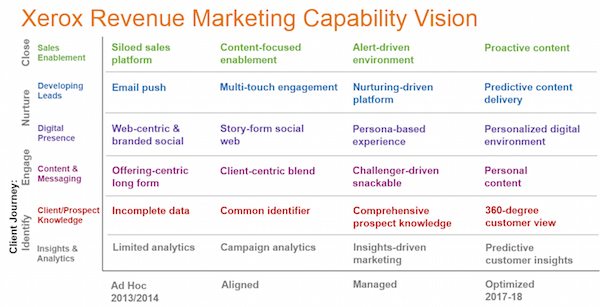Merkle and I were both born in 1971. Crikey, a lot has changed since then.
In 1971, Apollo 14 landed on the moon, the third Apollo mission to do so. An incredible feat of engineering — and also, if you read David Meerman Scott’s Marketing the Moon, a massive accomplishment in marketing too. But now we carry around the computing power of that spaceship in our smartphones. (Although some would say the iPhone 6+ is growing to the size of an early NASA mainframe.)
When Merkle was young, it was actually Merkle Computer Systems. But over time, they evolved into a database marketing company, a CRM company, an email marketing company, a creative agency.
Today, they’re blending the DNA of technology, marketing, and services into a new kind of agency that defies classical categorization.
I had the chance to catch up with Matt Mobley, Merkle’s own chief marketing technology officer, to learn about his role in the company and hear his perspective on the evolution of their firm and the changes they’re seeing in the agency environment.
Start by telling us a little about your background. What was your career journey to Merkle?
My technology career started in the United States Air Force, but my work in the marketing technology space didn’t start until my first job outside the military with a small consultancy out of Chattanooga, Tennessee. I started with Acxiom in 2000, and held numerous senior level roles at Acxiom. I was a client technology leader, led a product management function, and ultimately built and ran Acxiom’s European consulting business.
My Acxiom years built the foundation of my marketing technology skills and the association of these technology skills to real marketing objectives. I also developed my key philosophy for marketing technology. Clients do not hire us to build monuments to IT; clients hire us to enable marketing results.
In 2009, as we were coming out of the recession, I received an opportunity to join Epsilon to manage its solutions group and build a sales consulting function. Overall, the function of this group was to align marketing objectives to a set of technologies that would enable the client’s marketing organization to achieve those objectives.
After approximately three years, I received another opportunity to help a newly acquired business, IMPAQT, a search company, adapt to a CRM agency, Merkle. After moving through the transition with IMPAQT, I became the Chief Marketing Technology Officer at Merkle. In January, I will start my fourth year with Merkle.
What is your current role at Merkle? How does that fit in with the rest of Merkle’s management structure?
I am Merkle’s Chief Technology Officer and a member of Merkle’s Executive Committee. Merkle is organized in a matrix, with industry-based verticals and capability-based operating groups. My group is called the Enterprise Technology Group, which supports the vertical practices and the operating groups. We are responsible for product innovation and technology partnerships that enable operating groups to create solutions that allow the industry verticals to deliver against marketing objectives.
What does a day in your life look like? What are the toughest and most interesting parts?
My work life is divide into three parts. One part is focused on Merkle’s clients and prospects, another part is focused on product research and development, and the final part is focused on technology partnerships.
While time allocation between these parts can very greatly week to week, the core mission of the group is to develop technologies or partner with the right technology companies to enable meaningful marketing solutions for our clients.
The biggest challenge I face is the rapidly changing technology landscape and the ever-evolving business models and processes of companies in the martech and adtech spaces.
The biggest challenge I face is the rapidly changing technology landscape and the ever-evolving business models and processes of companies in the martech and adtech spaces. This challenge is both the toughest and the most interesting part. Due to the rapidly changing landscapes, you are always in learning mode. You have to carve out time to explore, ask questions and become knowledgeable about all the aspects of the space.
Clients look for a guide with a strong perspective on how to leverage tech innovations and help ease the adoption of that innovation for their organization. This situation gives me the opportunity to be at the forefront of many of the changes that take place. This makes it very exciting and it forces you to continually work hard to stay there.
What’s your take on the collision of adtech and martech? This seems like a particularly powerful intersection for Merkle. What are the opportunities? The challenges?
Merkle has really pushed on the idea of “Addressability at Scale.” This idea is based on the fact that every channel and media continually moves toward a point where organizations can specifically target individuals. Organizations can apply data and analytics to drive highly efficient individual-level targeting and personalization at massive scale.
This is where we see martech and adtech coalescing.
We are applying some of the same practices traditionally used to target known individuals in direct mail and email to the paid media space.
Individualization of targeting across an omni-channel consumer experience forces martech processes and technology further into the adtech space. We are applying some of the same practices traditionally used to target known individuals in direct mail and email to the paid media space, and we are linking the experiences across these media with specific channel experiences.
The opportunity lies in the fact that organizations can effectively widen the marketing funnel at all stages. They drive more high value customers through the top of the funnel and are more effective with those customer as they pass through the funnel.
There are numerous challenges. In general, things like cross-channel and media identification of individuals needs to mature, and organizations do not think about how they capture and react to the totality of the consumer’s experience.
The challenge within organizations is how to envision the new omni-channel marketing programs while they navigate or break down current silos.
The challenge within organizations is how to envision the new omni-channel marketing programs while they navigate or break down current silos. Large scale audience platforms, such as Facebook and Google, are busy building walled gardens that protect the value of their audiences, which in turn limits the marketer’s ability to effectively target individuals and measure effectiveness across all channels and media.
There are many internal and external forces working against the marketing organization’s ability to create a highly addressable omni-channel experience. One thing is for sure, there is a lot of change to come.
What kinds of other changes are you seeing in the marketing services and agency world these days? How is the relationship between firms like yours, more traditional creative agencies, and internal IT and marketing organizations evolving?
I believe companies like Merkle have a leg up on the more traditional agencies. While traditional agencies will always have a strong role in brand marketing, companies like us are quickly eroding their position below the core brand activities.
The traditional agencies are either buying or building [data, analytics, and technology] competencies, but lack the core experience to manage highly complex amalgamations of technology and marketing processes.
This is in part due to our experience in the application of data, analytics, and technology in highly targeted marketing activities. The traditional agencies are either buying or building these competencies, but lack the core experience to manage highly complex amalgamations of technology and marketing processes for true omni-channel marketing.
Merkle and other companies of this ilk are building creative capabilities married to the technologies that deliver robust omnichannel experiences. The industry as a whole is running from different directions toward the same opening. I believe our foundation will give us the better position in the end.
As for internal IT and their associated marketing organization, we are in the early stages of the awakening for internal IT. As technology budgets have shifted to the CMO and the CIO works to stay technologically relevant to the revenue engines of the organization, internal IT starts to understand the changes that need to take place.
Internal IT can no longer be focused on IT alone. They need to develop a more robust understanding of the organizations they support, especially marketing. We now see roles like marketing technologist appear in CIO organizations. While this is the first step to the solution, these IT organizations need to more aggressively align to the business objectives and adapt IT processes that fall in line with the hyper-evolution of technology that occurs in the CMO’s world. This will take some time.
IT organizations need to more aggressively align to the business objectives and adapt IT processes that fall in line with the hyper-evolution of technology that occurs in the CMO’s world.
How much responsibility does a brand need to take for its digital customer experience? How much of it can it look to external providers such as Merkle to deliver? Are you feeding them fish or teaching them how to fish?
At the end of the day, there is no question about the fact that brands are responsible for the entire customer experience. The challenge for brands is to navigate multiple agencies, multiple internal groups that control parts of the experience, and develop a holistic marketing program across all of the channels and media.
Layer in the need to measure the effectiveness of these marketing efforts without organizational and agency biases, and you have a real mess on your hands.
We approach this as an organization that can provide a holistic platform fueled by data and analytics to enable the brand and agency in marketing efforts. Where organizational confusion exists, our goal is to bring a set of frameworks and methodologies to help a brand gain better control of these efforts. When gaps exist in their strategies, especial considering true omni-channel experiences, we help brands develop and execute these strategies through our agency.
As to when a brand stops eating out and begins to cook their own dinner, it is dependent on numerous variables: resource constraints, knowledge transition, and ultimately how successful the programs are. If the programs are highly successful, the brands are less likely to take them in-house regardless of how prepared they are.
As to when a brand stops eating out and begins to cook their own dinner, it is dependent on numerous variables: resource constraints, knowledge transition, and ultimately how successful the programs are.
As we head into 2015, what are you most excited about?
What excites me most for 2015 is the idea that Addressability at Scale will further mature. We are getting closer and closer to truly connecting individual experiences across devices, channels, and media, and we are beginning to see the relationship of one individual’s experiences to another.
These connections coupled with further growth in massively-scaled audience platforms provide the foundation for rich personalized engagements with individual consumers at every touchpoint. The ability to manage these individualized omni-channel experiences will breed greater innovation in marketing technology platforms.
While this will not come into fruition in 2015, I believe further down the line these platforms will be where we manage individualized experiences across the Internet of Things. I can see a world where the marketer communicates integrated, personalized messages to the consumer through the refrigerator touchscreen, gaming console, set-top box, car GPS, Amazon’s Echo, a smart watch, and all connected devices. We have a long way to go, but we are definitely headed in an interesting direction.
Thanks, Matt!



